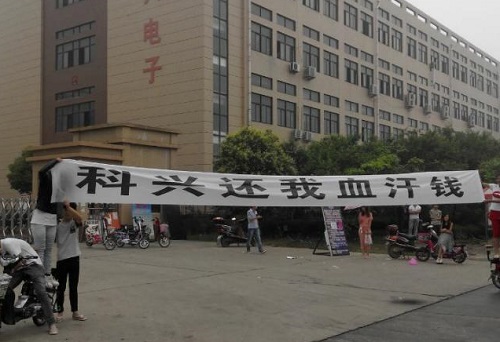Strikes and worker protests in China continued to gather pace in the second quarter of 2014 as workers demanded higher pay, social security, wages in arrears and compensation for factory relocations etc.
The number of wage arrears cases in particular increased noticeably during the quarter, reaching 46 in June alone, as the lack of liquidity in the Chinese economy started to impact on manufacturing and construction.

Workers outside an electronics factory in Henan demand payment of wages in arrears.
In all, China Labour Bulletin recorded 235 incidents on our Strike Map during this period, 49 percent higher than the same period last year, which had 158 incidents, and 180 percent higher than the second quarter of 2012, which featured 84 incidents.*
China’s factories were the focus of strike action in this quarter with nearly half the incidents (113 or 48 percent) occurring in the manufacturing sector. By far the biggest and most publicised strike was the massive two-week protest at the Yue Yuen shoe factory complex in Dongguan during April. The strike was noticeable both for its sheer size – around 40,000 workers took part at its height – and the fact that workers’ demands included the payment in full of social security contributions.
Worker grievances and demands related to social security are becoming increasingly common in China as middle-aged workers start to think more about retirement and the need to care for their children and elderly parents. We recorded at least 18 incidents during this period in which demands for social insurance were clearly stated by the strikers.
Yue Yuen was by far the largest factory protest during this period (in fact it was one of the largest in recent memory) but nearly a quarter of all the strikes in the manufacturing sector (27 out of 113) had more than 1,000 participants, suggesting that the ability of factory workers to organize and sustain large-scale strikes is improving.
While Guangdong has long been the epicentre of worker protests in China, especially in the manufacturing sector, the data from the second quarter of 2014 shows that other regions are beginning to catch up. While the number of strikes in Guangdong remained stable, the numbers in both Shandong and Jiangsu doubled compared with the same quarter last year. Guangdong’s share of all strikes in China dropped from 41 percent last year to 26 percent this year. And even in manufacturing, Guangdong’s share of the strike action fell from 61 percent in the second quarter of 2013 to 37 percent this year.
Transport strikes were spread all over the country from Yunnan to Liaoning and Xinjiang. There were a total of 62 strikes in the transport sector, 15 more than in the same period last year. As usual, the transport strikes were led by taxi drivers and bus company employees unhappy at long-standing problems; declining incomes, exploitative management and competition from unlicensed operators.
On 20 April, for example, thousands of workers at the Shenzhen East Public Transport Co. staged a peaceful demonstration outside the district government, demanding a more transparent wage calculation system, overtime payments in arrears, and better working conditions. In May, more than one thousand taxi drivers in Dongguan also took to the streets in protest at rental fees and the so called “tea money” paid to the cab companies. And in the remote northwest of China, hundreds of taxi drivers in Wujiaqu, Xinjiang, went on strike in protest at the local government withholding fuel subsidies and being forced to pay expensive insurance premiums.
Police intervened in 22 percent of the strikes and protests during this period and arrests were made in about nine percent of strikes, about average for the last few years, although obviously, as the number of strikes have increased so have the actual numbers of arrests and detentions.
However, it is clear from the detention and trial of prominent workers’ leaders and labour activists during the last quarter, that this intensification of police action has only emboldened the workers’ movement. Wu Guijun, who was released without charge after a year in detention, is now actively promoting workers’ rights again, as is Meng Han, leader of the Guangzhou hospital security guards, who was released after nine months in jail in May.
* The higher numbers might partly be caused by the rapid development of social media and widespread use of cheap smart phones among China’s workers, which have made strikes and protests much more visible.
